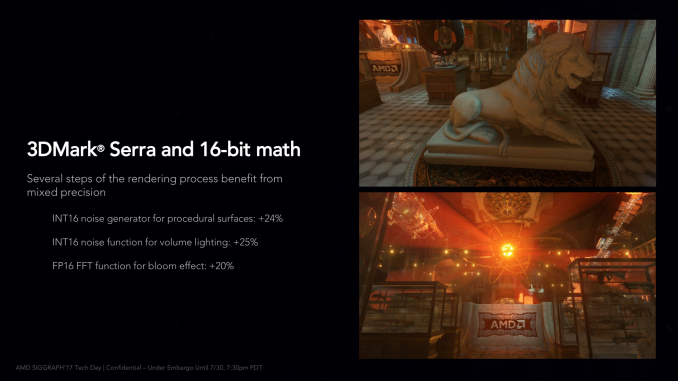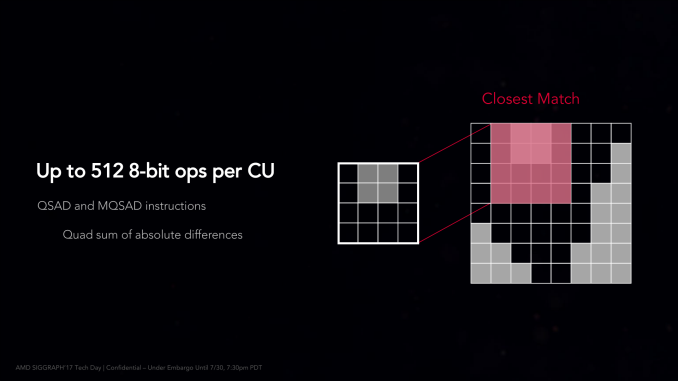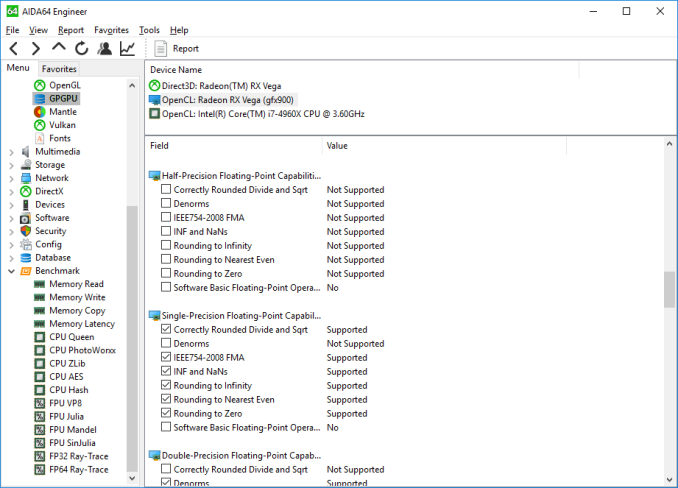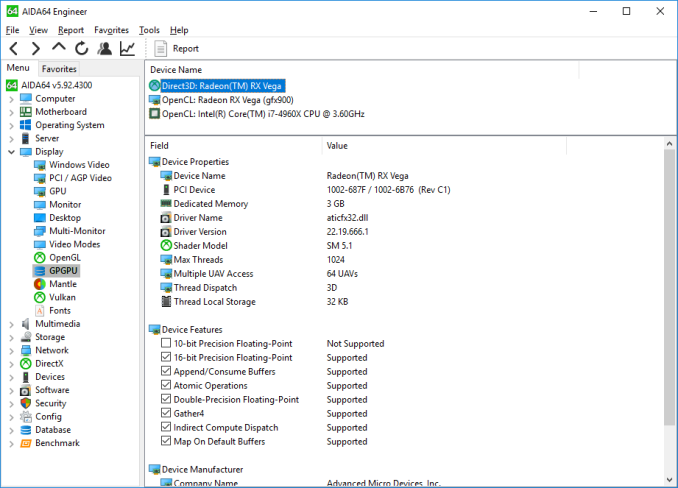The AMD Radeon RX Vega 64 & RX Vega 56 Review: Vega Burning Bright
by Ryan Smith & Nate Oh on August 14, 2017 9:00 AM ESTRapid Packed Math: Fast FP16 Comes to Consumer Cards (& INT16 Too!)
Arguably AMD’s marquee feature from a compute standpoint for Vega is Rapid Packed Math. Which is AMD’s name for packing two FP16 operations inside of a single FP32 operation in a vec2 style. This is similar to what NVIDIA has done with their high-end Pascal GP100 GPU (and Tegra X1 SoC), which allows for potentially massive improvements in FP16 throughput. If a pair of instructions are compatible – and by compatible, vendors usually mean instruction-type identical – then those instructions can be packed together on a single FP32 ALU, increasing the number of lower-precision operations that can be performed in a single clock cycle. This is an extension of AMD’s FP16 support in GCN 3 & GCN 4, where the company supported FP16 data types for the memory/register space savings, but FP16 operations themselves were processed no faster than FP32 operations.
The purpose of integrating fast FP16 and INT16 math is all about power efficiency. Processing data at a higher precision than is necessary unnecessarily burns power, as the extra work required for the increased precision accomplishes nothing of value. In this respect fast FP16 math is another step in GPU designs becoming increasingly min-maxed; the ceiling for GPU performance is power consumption, so the more energy efficient a GPU can be, the more performant it can be.
Taking advantage of this feature, in turn, requires several things. It requires API support and it requires compiler support, but above all it requires code that explicitly asks for FP16 data types. The reason why that matters is two-fold: virtually no existing programs use FP16s, and not everything that is FP32 is suitable for FP16. In the compute world especially, precisions are picked for a reason, and compute users can be quite fussy on the matter. Which is why fast FP64-capable GPUs are a whole market unto themselves. That said, there are whole categories of compute tasks where the high precision isn’t necessary; deep learning is the poster child right now, and for Vega Instinct AMD is practically banking on it.
As for gaming, the situation is more complex still. While FP16 operations can be used for games (and in fact are somewhat common in the mobile space), in the PC space they are virtually never used. When PC GPUs made the jump to unified shaders in 2006/2007, the decision was made to do everything at FP32 since that’s what vertex shaders typically required to begin with, and it’s only recently that anyone has bothered to look back. So while there is some long-term potential here for Vega’s fast FP16 math to become relevant for gaming, at the moment it doesn’t do much outside of a couple of benchmarks and some AMD developer relations enhanced software. Vega will, for the present, live and die in the gaming space primarily based on its FP32 performance.
The biggest obstacle for AMD here in the long-term is in fact NVIDIA. NVIDIA also supports native FP16 operations, however unlike AMD, they restrict it to their dedicated compute GPUs (GP100 & GV100). GP104, by comparison, offers a painful 1/64th native FP16 rate, making it just useful enough for compatibility/development purposes, but not fast enough for real-world use. So for AMD there’s a real risk of developers not bothering with FP16 support when 70% of all GPUs sold similarly don’t support it. It will be an uphill battle, but one that can significantly improve AMD’s performance if they can win it, and even more so if NVIDIA chooses not to budge on their position.
Though overall it’s important to keep in mind here that even in the best case scenario, only some operations in a game are suitable for FP16. So while FP16 execution is twice as fast as FP32 execution on paper specifically for a compute task, the percentage of such calculations in a game will be lower. In AMD’s own slide deck, they illustrate this, pointing out that using 16-bit functions makes specific rendering steps of 3DMark Serra 20-25% faster, and those are just parts of a whole.
Moving on, AMD is also offering limited native 8-bit support via a pair of specific instructions. On Vega the Quad Sum of Absolute Differences (QSAD) and its masked variant can be executed on Vega in a highly packed form using 8-bit integers. SADs are a rather common image processing operation, and are particularly relevant for AMD’s Instinct efforts since they are used in image recognition (a major deep learning task).
Finally, let’s talk about API support for FP16 operations. The situation isn’t crystal-clear across the board, but for certain types of programs, it’s possible to use native FP16 operations right now.
Surprisingly, native FP16 operations are not currently exposed to OpenCL, according to AIDA64. So within a traditional AMD compute context, it doesn’t appear to be possible to use them. This obviously is not planned to remain this way, and while AMD hasn’t been able to offer more details by press time, I expect that they’ll expose FP16 operations under OpenCL (and ROCm) soon enough.
Meanwhile, High Level Shader Model 5.x, which is used in DirectX 11 and 12, does support native FP16 operations. And so does Vulkan, for that matter. So it is possible to use FP16 right now, even in games. Running SiSoftware’s Sandra GP GPU benchmark with a DX compute shader shows a clear performance advantage, albeit not a complete 2x advantage, with the switch to FP16 improving compute throughput by 70%.
However based on some other testing, I suspect that native FP16 support may only be enabled/working for compute shaders at this time, and not for pixel shaders. In which case AMD may still have some work to do. But for developers, the message is clear: you can take advantage of fast FP16 performance today.
















213 Comments
View All Comments
rtho782 - Monday, August 14, 2017 - link
First? lolFireSnake - Monday, August 14, 2017 - link
Good! Now, let us read this in peace :)coolhardware - Monday, August 14, 2017 - link
Exactly. I am VERY excited to read about this, especially since AMD has been dragging this launch out for what seems forver.While reading I will also have another window open furiously refreshing http://amzn.to/2hZ9iPb (shortened URL for direct amd vega search on Amazon!) to see when they come in stock, and if we can get one before they sell out! ;-)
WOW, just checked and NewEgg is already out of EVERY Vega SKU :-( Like 15 different models from various brands :-( Bummer and I bet 80% are miners!
coolhardware - Monday, August 14, 2017 - link
BestBuy sold out of all of their SKUs as well. :-(Targon - Monday, August 14, 2017 - link
I ran into the Out of Stock, auto-notify on Newegg for hours....and suddenly one showed up that I could actually buy. So, I hit it, and it has been in packaging for the past five hours. Amazon really messed up with the Ryzen launch, allowing far more orders than the expected number of Ryzen 7 chips, to the point where it took several additional weeks before some of them shipped out. That is why I won't order a highly anticipated item from Amazon.Manch - Tuesday, August 15, 2017 - link
I ordered the Oculus package, the $399 one from Amazon on July 12th. They shipped the controllers two days ago. headset is out of stock until further notice. It was in stock when I ordered. Then it was all orders before July 15th will be filled first. Then it was the touch controllers are out of stock. Then the touch controllers ship but the headset is out of stock. Aggravating to say the least. They are one of the few that ships electronics to APO without being shitty about it or charging triple of actual costs.coolhardware - Tuesday, August 15, 2017 - link
Way to stick with it! Did Best buy complete your order? Fingers crossed for you :-)rtho782 - Monday, August 14, 2017 - link
I think the GTA5 1440p benchmarks and the BF1 load power consumption graphs made me laugh the most.I guess it's a pretty effective space heater. Maybe they want to discourage crypto mining by using more power to make it unprofitable.
It's a shame, we need more competition. *sigh*
Ratman6161 - Monday, August 14, 2017 - link
295 watts..?!?!?! Currently my whole system only pulls about 225 watts even when torture testing. That testing is only including CPU and RAM but other articles say my RX460 is about 104 watts during torture testing. So if I was stress testing CPU, RAM and video card all at once I'd be at around 329. Not a gamer myself but its hard for me to imagine over 500 watts for my system. Just doesn't make any sense in this day and age.Kratos86 - Monday, August 14, 2017 - link
Hmm you either don't understand how crypto mining works or what a joke is. Cryptominers generally turn the GPU clock down because it isn't very useful in these situations, even bandwidth isn't as relevant as latency. These cards with a bit of tweaking are getting 35 mh/s at $35 for $500. The Vega 56 blows the 64 away but both GPU's beat the RX 580 in terms of bang for buck and that's considering they haven't been optimised for mining performance yet.If these things hit 40 at $500 a piece, two for $1000, thats 80 mh/s for less than a Titan XP which at a cost of $1370 does around 37 mh/s. Saving $50 a year on power consumption and paying double the price for that privilege is not a very intelligent way to do things.
Suffice to say if you want one of these at the prices they are supposed to be selling at, you might get lucky and find one sometime this year because you are not finding these GPU's at these prices anytime soon and thats if they aren't sold out at any price. Unless AMD do something to get this in stock and keep it in stock the next few months are going to suck if you want one of these at prices that aren't inflated.
I guess AMD could have worst problems than "cryptominers keep buying our GPUs faster than we can make them" but it's still a situation they need to remedy.